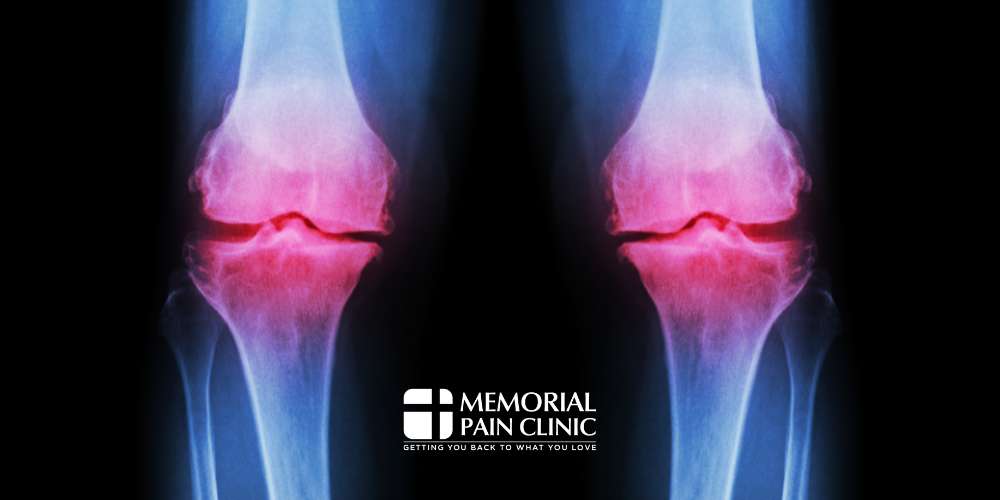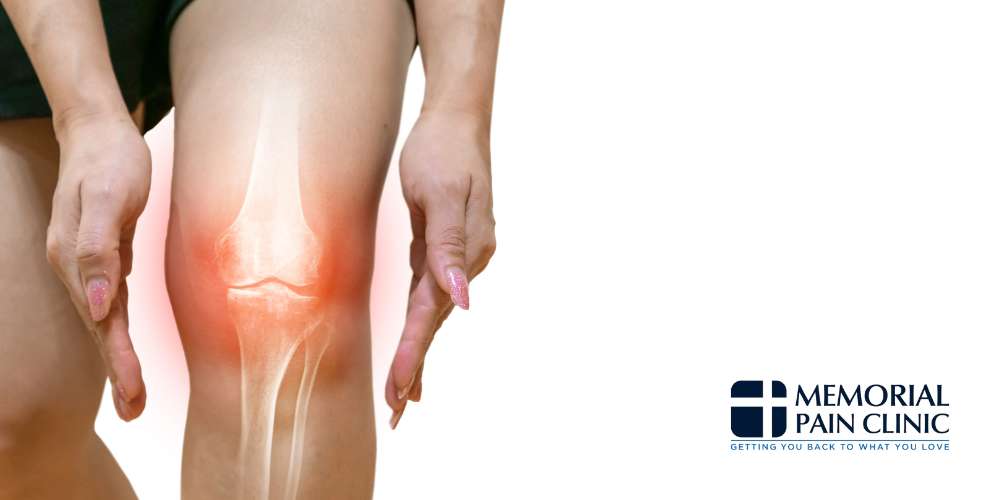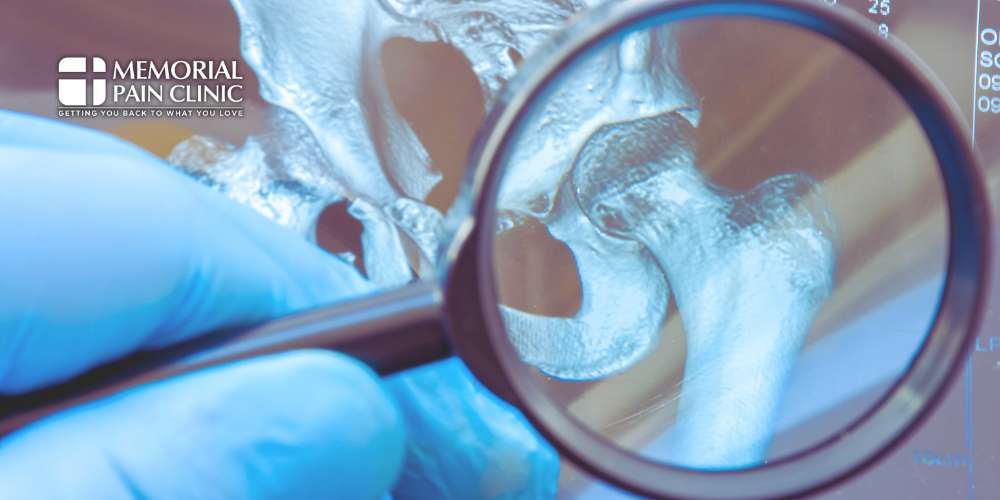Osteoarthritis Treatment Tulsa, OK
Our Services

Living with osteoarthritis can make everyday activities challenging, but effective osteoarthritis treatment in Tulsa, OK, is available at Memorial Pain Clinic. We are a trusted non-surgical pain management clinic serving the Tulsa community with a dedicated team of healthcare professionals. Our approach includes advanced diagnostic tools, personalized care plans, and therapies designed to relieve pain, restore mobility, and improve your quality of life.
Whether you’re dealing with osteoarthritis pain in weight-bearing joints or seeking arthritis pain relief for other affected joints, we are here to help. Call Memorial Pain Clinic at (918) 200-9944 today to schedule your appointment and start your journey toward osteoarthritis treatment in Tulsa, OK, and lasting pain relief.
What Is Osteoarthritis?
Osteoarthritis, often called a degenerative joint disease, is the most common form of arthritis. It occurs when the cartilage in your joints wears down over time, leading to joint stiffness, pain, and reduced range of motion.
Primary osteoarthritis develops due to natural aging and the gradual wear and tear on joints. It typically affects weight-bearing joints like the knees, hips, and spine.
Secondary osteoarthritis, on the other hand, results from an underlying condition or injury, such as a joint fracture or repetitive motions, that accelerates joint wear. Both types can lead to severe pain and a painful joint that impacts daily activities, making early treatment crucial.
Osteoarthritis vs Arthritis
While osteoarthritis is a common form of arthritis, it differs from other types, such as rheumatoid arthritis. Osteoarthritis is a wear-and-tear condition, while rheumatoid arthritis is an autoimmune disease that causes inflammation in multiple joints. Understanding these differences can guide your treatment options, especially when considering whether you might benefit from anti-inflammatory medications or other arthritis pain relief measures.
Is Osteoarthritis an Autoimmune Disease?
No, osteoarthritis is not an autoimmune disease. Unlike inflammatory arthritis, which is caused by an overactive immune system, osteoarthritis results from joint damage due to aging, repetitive motions, or injury.
Inflammatory arthritis encompasses several types of arthritis that stem from immune system dysfunction. These include:
- Rheumatoid Arthritis: A condition where the immune system attacks the joints, leading to pain, swelling, and stiffness.
- Psoriatic Arthritis: Associated with psoriasis, this type causes joint inflammation and skin symptoms.
- Ankylosing Spondylitis: A form of arthritis that primarily affects the spine, leading to severe pain and stiffness.
Identifying the specific type of arthritis you’re dealing with can help your doctor determine the best course of action to ease pain and improve joint movement.
Osteoarthritis Symptoms

According to the Arthritis Foundation, common symptoms of osteoarthritis include joint pain, stiffness, swelling, and limited range of motion. These symptoms often worsen with activity and improve with rest. As the disease progresses, you may notice severe symptoms such as limited joint movement, arthritic pain that interferes with daily life, and the development of bone spurs.
What Does Osteoarthritis Feel Like?
Osteoarthritis pain often feels like a deep ache in the affected joint. Many patients also report joint stiffness in the morning or after long periods of inactivity. This pain can become severe, especially in advanced cases where joint damage affects range of motion and everyday tasks become difficult.
Does Osteoarthritis Cause Swelling?
Yes, osteoarthritis can cause swelling in the affected joint. This occurs when the surrounding tissues become irritated due to joint damage. Swelling can contribute to additional discomfort and joint stiffness, making it harder to manage tasks involving weight-bearing joints like the knees or hips.
Does Osteoarthritis Spread?
Osteoarthritis does not spread from one joint to another. However, individuals may develop osteoarthritis in multiple joints due to factors such as aging, repetitive motions, or genetic predisposition. The same joints that bear the brunt of daily wear and tear, such as the knee joint or hip joint, are often the most affected.
What Causes Osteoarthritis?
Osteoarthritis develops when the cartilage that cushions your joints wears down. Contributing factors include aging, obesity, joint injuries, repetitive motions, and genetic predisposition. Maintaining a healthy weight and avoiding repetitive stress on joints can help protect joints from damage and reduce the risk of developing osteoarthritis in weight-bearing joints.
Is Osteoarthritis Hereditary?
While osteoarthritis is not directly hereditary, genetic factors can increase your risk. A family history of osteoarthritis may predispose you to develop the condition, especially in weight-bearing joints like the knee and hip joint. Understanding your medical history can provide valuable insights for diagnosis and treatment.
Can Osteoarthritis Be Reversed?
Osteoarthritis cannot be reversed, but its progression can be managed. Treatments such as physical therapy, assistive devices, and anti-inflammatory medications aim to ease pain and reduce symptoms. Regular exercise can improve muscle strength around the affected joint, supporting better joint movement and overall function.
What Age Does Osteoarthritis Start?
Osteoarthritis typically begins after the age of 40, though it can develop earlier in individuals with joint injuries or those who perform repetitive motions. Early detection is key to effective treatment, as identifying osteoarthritis symptoms early can help minimize pain and maintain joint health.
How to Diagnose Osteoarthritis

To diagnose osteoarthritis, our team will take a systematic approach to ensure an accurate understanding of your condition. This process includes:
- Review of Medical History: Understanding your medical history helps identify potential risk factors, such as past injuries, family history, or other medical problems that could contribute to osteoarthritis.
- Physical Exam: A thorough physical exam allows us to evaluate joint stiffness, swelling, range of motion, and signs of joint damage.
- Imaging Tests: Diagnostic tools like magnetic resonance imaging (MRI) or X-rays provide detailed images of your joints, helping to confirm osteoarthritis and assess the extent of damage.
- Blood Tests: These are used to rule out other conditions, such as rheumatoid arthritis or autoimmune diseases, that might mimic osteoarthritis symptoms.
- Assessment of Symptoms: We discuss the severity and type of pain you’re experiencing, including severe pain or intermittent discomfort in specific joints.
This comprehensive diagnostic approach ensures your osteoarthritis treatment plan is tailored to your unique needs and condition.
What Is the Best Treatment for Osteoarthritis?
The best osteoarthritis treatment depends on the severity of your symptoms and your overall health. Non-surgical options include physical therapy, occupational therapy, and anti-inflammatory medications to relieve pain and stiffness. For severe cases, joint replacement surgery may be considered. Manual therapy, provided by a physical therapist, can also help relieve stiffness and improve joint function.
Osteoarthritis Surgery
Surgery is often a last resort for osteoarthritis pain that does not respond to conservative treatments. Different surgical procedures are available depending on the severity and location of the condition. Common options include knee replacement surgery and joint replacement surgery, which involve replacing the damaged joint with an artificial joint. These procedures can significantly improve mobility and reduce pain for those with severe symptoms, offering a path to restored function and a better quality of life.
Non-Surgical Osteoarthritis Treatments
Non-surgical treatments focus on pain relief and improving joint movement. Options include physical therapy, manual therapy, occupational therapy, and lifestyle modifications such as losing weight and using assistive devices like shoe inserts. These treatments help minimize pain and improve mobility, especially in weight-bearing joints like the knees and hips.
Medicine for Osteoarthritis
Medications play a significant role in managing osteoarthritis symptoms. These treatments are available in various forms, including pills, syrups, patches, gels, creams, or injectables. The Arthritis Foundation suggests the following medications for the treatment of osteoarthritis:
- Analgesics: Pain relievers such as acetaminophen, which is available over the counter (OTC), and opioids, which must be prescribed by a doctor.
- Nonsteroidal Anti-inflammatory Drugs (NSAIDs): These are the most commonly used medications to ease inflammation and pain, including aspirin, ibuprofen, naproxen, and celecoxib. They are available OTC or by prescription.
- Counterirritants: OTC products containing ingredients like capsaicin, menthol, or lidocaine that provide relief by irritating nerve endings, creating sensations like warmth or cooling to distract from pain.
- Corticosteroids: Prescription anti-inflammatory medicines taken orally or injected into the joint by a doctor to reduce inflammation.
- Platelet-Rich Plasma (PRP): A newer injectable treatment intended to reduce pain and inflammation. It is not FDA-approved, so discuss this option thoroughly with your doctor.
- Other Drugs: Duloxetine (Cymbalta), an antidepressant, and pregabalin (Lyrica), an anti-seizure drug, are FDA-approved for treating osteoarthritis pain.
Your physical therapist or occupational therapist may also recommend therapies to protect joints, assist with Tulsa medication management, and ease pain associated with muscle spasms.
Contact Memorial Pain Clinic for Osteoarthritis Treatment in Tulsa, OK

At Memorial Pain Clinic, we are dedicated to providing comprehensive care for osteoarthritis. Our team of skilled professionals works closely with you to create a personalized treatment plan that addresses your specific needs. Whether you’re managing knee pain, joint stiffness, or other arthritic symptoms, we offer a variety of effective solutions to help you regain your mobility and improve your quality of life.
Don’t let osteoarthritis pain hold you back from enjoying everyday activities. Contact us today at (918) 200-9944 to schedule an appointment and start your journey toward pain relief and better joint health.
